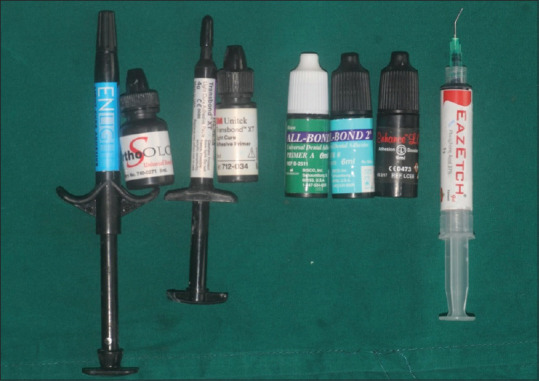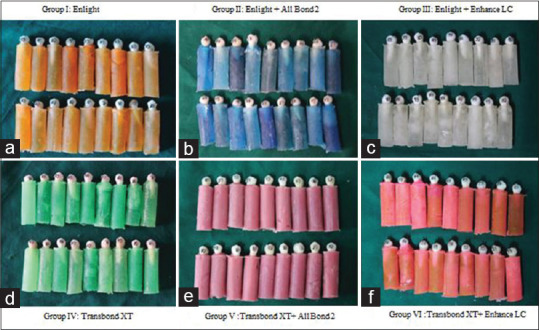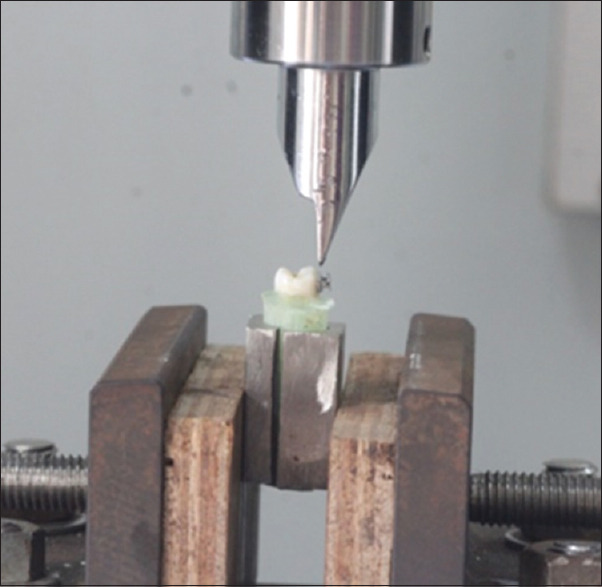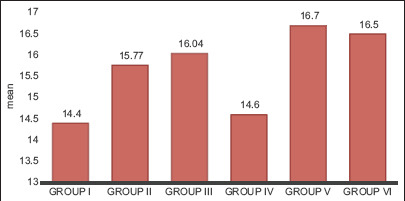Abstract
Context:
Effect of adhesion boosters on shear bond strength of orthodontic brackets.
Aim:
The aim is to evaluate the shear bond strength and adhesive remnant index (ARI) score of new brackets bonded to a debonded tooth surface with and without the use of adhesion boosters.
Settings and Designs:
In vitro comparative study.
Materials and Methods:
Adhesion boosters: Enhance LC (Reliance, Itasca III) All Bond 2 (Bisco, Schaumsburg) and the Composite adhesives Transbond XT (3M UNITEK) Enlight (ORMCO) were used in this study. One hundred and eight extracted maxillary first premolar teeth were bonded with light cure composite to etched tooth surface. The brackets were then debonded with debonding pliers after 1 week and it was polished with low speed tungston carbide bur and rubber cup. The teeth were divided into six groups and they were etched, washed, and dried again. New brackets were rebonded to the tooth surface using composites with or without adhesion boosters. Then, the shear bond strength value was calculated for each bracket with a universal testing machine. ARI scores were also evaluated.
Statistical Analysis Used:
One-way ANOVA and least significant difference post hoc test was used for the association between variables. Probability value (P < 0.05) was considered statistically significant.
Results:
The results showed a statistically significant difference between the groups with a P < 0.001. There was no significant difference in ARI scores between the groups (P = 0.15).
Conclusions:
Both the adhesion boosters significantly improved the shear bond strength of orthodontic brackets. There was no statistically significant difference in the ARI scores.
Keywords: Adhesion boosters, All Bond 2, Enhance LC, shear bond strength
Introduction
The development of new orthodontic adhesives has allowed orthodontists to successfully bond the brackets directly to the tooth surface. The three most important factors affecting the bond strength between a bracket and enamel surface are: the retention mechanism at the base of the bracket, the adhesive material, and the preparation of tooth surface.[1] In clinical practice, patients occasionally report with debonded brackets. These failed brackets might be either distorted or lost, making the use of a new bracket unavoidable. Rebonding to this debonded tooth surface is likely to produce less shear bond strength as the debonded enamel surface is an altered one. Adhesion boosters, a tooth surface primer advocated by Bowen et al., to increase the bond strength of composite resin to the tooth surface, have been available in dentistry for many years.[2] Two commercially available adhesion boosters Enhance LC and All Bond 2 were used in this study.
A study conducted by Chung et al., in 2000, showed that All Bond 2 provided better bond strength than Enhance LC when used with rebonded brackets.[3] Sandblasted rebonded brackets with All Bond 2 showed comparable bond strength to new brackets without adhesion boosters. Vicente et al., in 2004, showed that Enhance LC is material specific as stated by the manufacturers, as it showed extra bond strength when used with Light- bond than with other composites such as Transbond XT.[4] In 2006, Vicente et al. compared the bond strength of new brackets using 3 adhesion boosters (Ortho solo, Enhance LC, All Bond 2) and reported that Enhance LC showed greatest bond strength when used with material specific product Light-bond.[5]
The purpose of this study was to compare the bond strength of new brackets bonded to a debonded tooth surface with different combinations of two light cure composites with and without the use of adhesion boosters.
Materials and Methods
Sample size calculation
With a standard deviation of 6.3 and 10% error, 18 samples were taken in each group. The number of groups was 6, and the total sample size was 18 × 6 = 108.
Bonding procedure
Adhesion boosters-Enhance LC (Reliance, Itasca III) All Bond 2 (Bisco, Schaumsburg and the Composite adhesives Transbond XT (3M UNITEK) Enlight (ORMCO), were used in this study [Figure 1]. One hundred and eight extracted maxillary first premolar teeth were bonded with light cure composite to etched tooth surface (Etchant – 37% phosphoric acid – Eazetch (Anabond Steadmann), composite – Transbond XT) using stainless steel Mini 2000 brackets (ORMCO 022” MBT). Excess bonding material was removed carefully and light cured for 20 s each on mesial and distal side using light emitting diode curing unit (Koden reliable dental products) as recommended by the manufacturer. The brackets were then debonded with debonding pliers after 1 week and the teeth were kept in distilled water for 3–5 days. Distilled water was used as storage medium instead of artificial saliva, since previous studies have shown that samples stored in distilled water showed comparable shear bond strength values to the clinically acceptable bond strength of 6–8 mega pascals (MPa).[6]
Figure 1.

Bonding materials
Rebonding procedure
The enamel surface was polished with low-speed tungston carbide bur and rubber cup. The debonded premolar teeth were divided into six groups. The six groups were color coded for ease of identification [Figure 2]. The teeth were etched, washed, and dried again. New brackets were rebonded to the tooth surface using composites with or without adhesion boosters [Table 1].
Figure 2.

Color coded testing blocks. (a) Group I: Enlight, (b) Group II: Enlight + All Bond 2, (c) Group III: Enlight + Enhance LC, (d) Group IV: Transbond XT, (e) Group V: Transbond XT + All Bond 2, (f) Group VI: Transbond XT + Enhance LC
Table 1.
Testing groups
| Group | Color coding | Composite | Adhesion booster |
|---|---|---|---|
| Group I | Orange | Enlight | |
| Group II | Blue | Enlight | All Bond 2 |
| Group III | White | Enlight | Enhance LC |
| Group IV | Green | Transbond XT | |
| Group V | Opaque pink | Transbond XT | All Bond 2 |
| Group VI | Pink | Transbond XT | Enhance LC |
In Group I, a thin coat of Ortho Solo bonding agent was applied to the etched enamel and light cured for 10 s. Enlight composite paste was then applied on to the new bracket base.
In Group II, a thin layer (4–5 strokes with a brush) of All-Bond 2 primer A and B mixture was applied on to the etched and slightly moistened enamel and lightly dried with an air syringe until a glossy appearance became visible. A thin coat of Ortho Solo bonding agent was then applied directly on the All Bond 2 coated layer and light cured for 10 s. Enlight composite paste was then applied on to the new bracket base.
In Group III, a thin layer (4–5 strokes with a brush) of Enhance LC was applied on to the etched dried enamel and lightly dried with an air syringe. A thin coat of Ortho Solo bonding agent was then applied directly on the Enhance LC coated layer and light cured for 10 s. Enlight composite paste was then applied on to the new bracket base.
In Group IV, a thin coat of Transbond XT primer was applied to the etched enamel and light cured for 10 s. Transbond XT composite adhesive was then applied on to the new bracket base.
In Group V, a thin layer (4–5 strokes with a brush) of All-Bond 2 primer A and B mixture was applied on to the etched and slightly moistened enamel and lightly dried with an air syringe until a glossy appearance became visible. A thin coat of Transbond XT primer was then applied directly on the All Bond 2 coated layer and light cured for 10 s. Transbond XT composite adhesive was applied to the new bracket base.
In Group VI, a thin layer (4–5 strokes with a brush) of Enhance LC was applied on etched dried enamel surface and was lightly dried with an air syringe. A thin coat of Transbond XT primer was then applied directly on the Enhance LC-coated layer and light cured for 10 s. Transbond XT composite adhesive was then applied on to the new bracket base.
Excess bonding material was removed with an explorer and it was light cured for 20 s each on mesial and distal side of the bracket.
Testing of shear bond strength
The shear bond strength test was conducted in the laboratory. A universal testing machine (Shimadzu Autograph AG-IS) was used for shear bond testing at a cross head speed of 1 mm/min. Each tooth's facial surface was parallel to the direction of force during the shear strength testing. The force was applied to the bracket tooth interface by a flattened steel rod [Figure 3]. The load at the bracket failure was recorded by a computer connected to the testing machine. The shear bond strength values were calculated in MPa by dividing the force by the area of the bracket base (9.63 mm2).
Figure 3.

Testing of shearbond strength
The bracket bases of all the brackets were again examined visually to determine the location and manner of bond failure and adhesive remnant index (ARI) scores noted[7] [Table 2].
Table 2.
Adhesive remnant index scores
| Score | Criteria |
|---|---|
| 0 | No adhesive left on tooth |
| 1 | Less than half of adhesive left on tooth |
| 2 | More than half of adhesive left on tooth |
| 3 | All adhesive left on the tooth, with distinct impression of the bracket mesh |
Statistical methods
All statistical procedures were performed using Statistical Package for Social Sciences 20.0. (SPSS Inc., Chicago, Ill., USA). Calculations for power (80%) of study were performed before commencement of the study. The Shapiro–Wilk test was used for testing the normality assumption of the data. One-way ANOVA and least significant difference post hoc test was used for the association between variables. Probability value (P < 0.05) was considered statistically significant.
Results
The highest mean shear bond strength was observed for Group V, i.e., Transbond XT + All Bond 2 combination (16.70 ± 0.48 MPa). The lowest mean shear bond strength was for Group I, i.e., composite Enlight only (14.40 ± 0.30 MPa). The differences between the shear bond strength values of the six groups were statistically significant, since the P < 0.001 [Table 3 and Graph 1]. The multiple comparison data showed that the differences between the mean shear bond strength of each pair of group are statistically significant except for Groups I and IV, Groups II and III, and Groups V and VI [Table 4]. The inference is that composites Enlight and Transbond XT when used alone showed no statistically significant difference in mean shear bond strength. Adhesion boosters All Bond 2 and Enhance LC when used along with both the composites also showed no statistically significant difference in mean shear bond strength.
Table 3.
Shear bond strength of all groups
| Group | Mean | SD | Minimum-Maximum | P |
|---|---|---|---|---|
| Group I | 14.40 | 0.30 | 13.45-14.68 | 0.000* |
| Group II | 15.77 | 0.62 | 13.40-16.26 | |
| Group III | 16.04 | 0.33 | 15.75-17.28 | |
| Group IV | 14.60 | 0.59 | 12.97-15.44 | |
| Group V | 16.70 | 0.48 | 15.51-17.99 | |
| Group VI | 16.5 | 0.51 | 15.13-17.14 |
*P<0.05 is statistically significant; SD: Standard deviation
Graph 1.

Comparison of mean shear bond strength
Table 4.
Post hoc comparison within group by least significant difference test
| Group | Mean | SD |
|---|---|---|
| Group I | 14.40abcd | 0.30 |
| Group II | 15.77aefg | 0.62 |
| Group III | 16.04bhij | 0.33 |
| Group IV | 14.60ehk | 0.59 |
| Group V | 16.70cfik | 0.48 |
| Group VI | 16.5dgj | 0.51 |
Same alphabets indicate significant difference across groups. SD: Standard deviation
ARI data showed a similar pattern of tooth bracket failure in all groups [Table 5]. There was no significant difference between the groups (P = 0.15) [Table 6]. Groups I, II and IV showed the highest percentage of score 2 (61%, 44%, and 50%, respectively), Groups III and V have highest percentage of score 1 (50% and 37%). Group 6 has equal percentage of score 1 and score 4 (33%). This means that most of the bracket failure occurred in the resin bracket interface. The highest mean ARI score was for Group IV, i.e., composite Transbond XT alone. The lowest mean ARI score was for Groups III and V, i.e., Enlight along with Enhance LC and Transbond XT along with All Bond 2.
Table 5.
Adhesive remnant index scoring of the testing groups
| Group name | Score 0, n (%) | Score 1, n (%) | Score 2v | Score 3, n (%) | Total, n |
|---|---|---|---|---|---|
| Group I | 2 (11.1) | 3 (16.6) | 11 (61.1) | 2 (11.1) | 18 |
| Group II | 1 (5.5) | 4 (22.2) | 8 (44.4) | 5 (27.7) | 18 |
| Group III | 3 (16.6) | 9 (50) | 2 (11.1) | 4 (22.2) | 18 |
| Group IV | 1 (5.5) | 2 (11.1) | 9 (50) | 6 (33.3) | 18 |
| Group V | 4 (22.2) | 7 (38.8) | 3 (16.6) | 4 (22.2) | 18 |
| Group VI | 2 (11.1) | 6 (33.3) | 4 (22.2) | 6 (33.3) | 18 |
Table 6.
Mean Adhesive Remnant Index score
| Group name | Mean ARI score | SD | P |
|---|---|---|---|
| Group I | 1.72 | 0.82 | 0.15 |
| Group II | 1.94 | 0.87 | |
| Group III | 1.38 | 1.03 | |
| Group IV | 2.11 | 0.83 | |
| Group V | 1.38 | 1.09 | |
| Group VI | 1.77 | 1.06 |
SD: Standard deviation; ARI: Adhesive remnant index
Discussion
Over the years, advances in the development of adhesives have allowed orthodontists to bond either new or debonded brackets to tooth surfaces more successfully and efficiently. Bowen and Marjenhoff in 1991 advocated the use of adhesion booster for the first time.[2] In 1995, Newman et al. concluded that adhesion promoters and Seal Coating resulted in an increase in bond strength of as much as 13.3 MPa.[8]
An ideal adhesion promoter is described as one that is adsorbed on to the enamel surface as a monomolecular layer and prevent contamination of the solid by organic substances.[9] The adhesion booster Enhance LC is composed of hydroxyethyl methacrylate (HEMA), tetrahydrofurfuryl cyclohexane dimethacrylate, and ethanol. The HEMA molecule contains two functional groups, one hydrophobic and the other hydrophilic.[10] Incorporation of hydrophilic monomers helps resin to infiltrate etched enamel at the level of the prisms which reduce interfacial porosity and therefore increase adhesion, achieving a greater bond strength through polymerization.[11] Adhesion booster All Bond 2 primer contains hydrophilic monomers in an acetone solvent, which provide a “water-chasing” ability.[12]
In the present study, the adhesion booster All Bond 2, when used along with composite Enlight, showed a mean bond strength of 15.77 MPa, whereas the combination of All Bond 2 and Transbond showed a mean bond strength of 16.7 MPa. The difference in shear bond strength between these groups was statistically significant. Likewise, adhesion booster Enhance LC, when used with composite Enlight showed mean bond strength of 16.04 MPa. Whereas with composite Transbond XT, mean shear bond strength was 16.50 MPa. This difference was also statistically significant.
In a study by Vamsilatha et al., they studied the efficacy of adhesion promoters on compromised hypocalcified enamel and they observed that shear bond strength ranged from 9.41 to 14.38 MPa for all the groups which indicated excellent bond strength above the clinically accepted range of 6–8 MPa.[13]
These results are consistent with the values obtained from Adanir et al., who have concluded that fluoride affected enamel significantly reduced the bond strength.[14] In contrast to their study, the results obtained by Ng'ang'a et al., revealed that there was no significant difference in the bond strength of brackets bonded to fluorotic enamel and nonfluorotic enamel.[15] However, in the present study, bond strength tests were performed on extracted teeth with normal enamel; for tooth surfaces with fluorosed or hypocalcified enamel or restorations, the effects of adhesion boosters on the bond strength of orthodontic brackets may be different.
In the present study, ARI data showed a similar pattern of tooth bracket failure in all groups. There was no significant difference between the groups (P = 0.15). Groups I, II, and IV showed the highest percentage of score 2, Groups III and V had highest percentage of score 1. Group 6 had equal percentage of score 1 and score 4. This means that most of the bracket failure occurred in the resin bracket interface. This is in agreement with the previous study by Chung et al., where ARI data showed a similar pattern of tooth/bracket interface failure with and without the use of adhesion boosters.[3]
One of the major limitations of the present study is that, being an in vitro study, it could not replicate the oral environment. Murray and Hobson had compared the in vivo and in vitro shear bond strength of orthodontic brackets and found that the mean bond strength of Transbond exposed to the oral environment for 4 weeks was significantly less than when exposed to a control environment of sterile water at 37°C for 4 weeks.[16]
The enthusiasm toward better, easier, and efficient techniques that reduces the chairside time and burden of the clinician have lead us to the newer bonding methods throughout the timeline. Hence, the use of adhesion boosters in orthodontics can certainly improve the treatment quality and save the operator's time in rebonding the bracket.
Conclusions
Adhesion boosters increased the shear bond strength of new orthodontic brackets bonded to a debonded tooth surface.
There was no statistically significant difference between composites Transbond XT and Enlight when used without adhesion boosters.
There was no statistically significant difference in the mean shear bond strength between the two adhesion boosters when used along with the composites Enlight and Transbond XT.
Both the adhesion boosters showed significantly higher mean shear bond strength value when used along with the composite Transbond XT than with Enlight.
The ARI data showed a similar pattern of tooth bracket failure in all groups. There was no significant difference between the groups with all the groups having highest percentage of scores 1 or 2. This means that most of the bracket failure occurred in the resin-bracket interface which is favorable to avoid enamel fractures.
Financial support and sponsorship
Nil.
Conflicts of interest
There are no conflicts of interest.
References
- 1.Urabe H, Rossouw PE, Titley KC, Yamin C. Combinations of etchants, composite resins, and bracket systems: An important choice in orthodontic bonding procedures. Angle Orthod. 1999;69:267–75. doi: 10.1043/0003-3219(1999)069<0267:COECRA>2.3.CO;2. [DOI] [PubMed] [Google Scholar]
- 2.Bowen RL, Marjenhoff WA. Development of an adhesive bonding system. Oper Dent. 1992;(Suppl 5):75–80. [PubMed] [Google Scholar]
- 3.Chung CH, Fadem BW, Levitt HL, Mante FK. Effects of two adhesion boosters on the shear bond strength of new and rebonded orthodontic brackets. Am J Orthod Dentofacial Orthop. 2000;118:295–9. doi: 10.1067/mod.2000.104810. [DOI] [PubMed] [Google Scholar]
- 4.Vicente A, Bravo LA, Romero M, Ortíz AJ, Canteras M. Bond strength of brackets bonded with an adhesion promoter. Br Dent J. 2004;196:482–5. doi: 10.1038/sj.bdj.4811178. [DOI] [PubMed] [Google Scholar]
- 5.Vicente A, Bravo LA, Romero M, Ortíz AJ, Canteras M. Effects of 3 adhesion promoters on the shear bond strength of orthodontic brackets: An in vitro study. Am J Orthod Dentofacial Orthop. 2006;129:390–5. doi: 10.1016/j.ajodo.2004.08.022. [DOI] [PubMed] [Google Scholar]
- 6.Sachdeva K, Singla A, Mahajan V, Jaj HS, Saini SS. Effect of storage media on shear bond strength of orthodontic brackets: An in vitro study. J Ind Orthod Soc. 2012;46:203–9. [Google Scholar]
- 7.Artun J, Bergland S. Clinical trials with crystal growth conditioning as an alternative to acid-etch enamel pretreatment. Am J Orthod. 1984;85:333–40. doi: 10.1016/0002-9416(84)90190-8. [DOI] [PubMed] [Google Scholar]
- 8.Newman GV, Newman RA, Sun BI, Ha JL, Ozsoylu SA. Adhesion promoters, their effect on the bond strength of metal brackets. Am J Orthod Dentofacial Orthop. 1995;108:237–41. doi: 10.1016/s0889-5406(95)70015-3. [DOI] [PubMed] [Google Scholar]
- 9.Jedrychowski JR, Caputo AA, Foliart R. Effects of adhesion promoters on resin-enamel retention. J Dent Res. 1979;58:1371–6. doi: 10.1177/00220345790580041201. [DOI] [PubMed] [Google Scholar]
- 10.Nakabayashi N, Kojima K, Masuhara E. The promotion of adhesion by the infiltration of monomers into tooth substrates. J Biomed Mater Res. 1982;16:265–73. doi: 10.1002/jbm.820160307. [DOI] [PubMed] [Google Scholar]
- 11.Hotta K, Mogi M, Miura F, Nakabayashi N. Effect of 4-MET on bond strength and penetration of monomers into enamel. Dent Mater. 1992;8:173–5. doi: 10.1016/0109-5641(92)90077-p. [DOI] [PubMed] [Google Scholar]
- 12.Hoogan P, Nayak RS, Pasha A, Teja SS, Vinay K, Narayan A. Effects of three adhesion promoters on the shear bond strength of new and recycled orthodontic brackets – An in vitro study. Indian J Dent. 2011;2:68–75. [Google Scholar]
- 13.Vamsilatha K, Venkata KM, Aileni KR, Sashidhar NR. Efficacy of new adhesion promoters on compromised hypocalcified enamel. J Clin Diagn Res. 2015;9:ZC09–11. doi: 10.7860/JCDR/2015/13249.6158. [DOI] [PMC free article] [PubMed] [Google Scholar]
- 14.Adanir N, Türkkahraman H, Yalçin Güngör A. Effects of adhesion promoters on the shear bond strengths of orthodontic brackets to fluorosed enamel. Eur J Orthod. 2009;31:276–80. doi: 10.1093/ejo/cjn093. [DOI] [PubMed] [Google Scholar]
- 15.Ng'ang'a PM, Ogaard B, Cruz R, Chindia ML, Aasrum E. Tensile strength of orthodontic brackets bonded directly to fluorotic and nonfluorotic teeth: An in vitro comparative study. Am J Orthod Dentofacial Orthop. 1992;102:244–50. doi: 10.1016/S0889-5406(05)81059-5. [DOI] [PubMed] [Google Scholar]
- 16.Murray SD, Hobson RS. Comparison of in vivo and in vitro shear bond strength. Am J Orthod Dentofacial Orthop. 2003;123:2–9. doi: 10.1067/mod.2003.49. [DOI] [PubMed] [Google Scholar]


